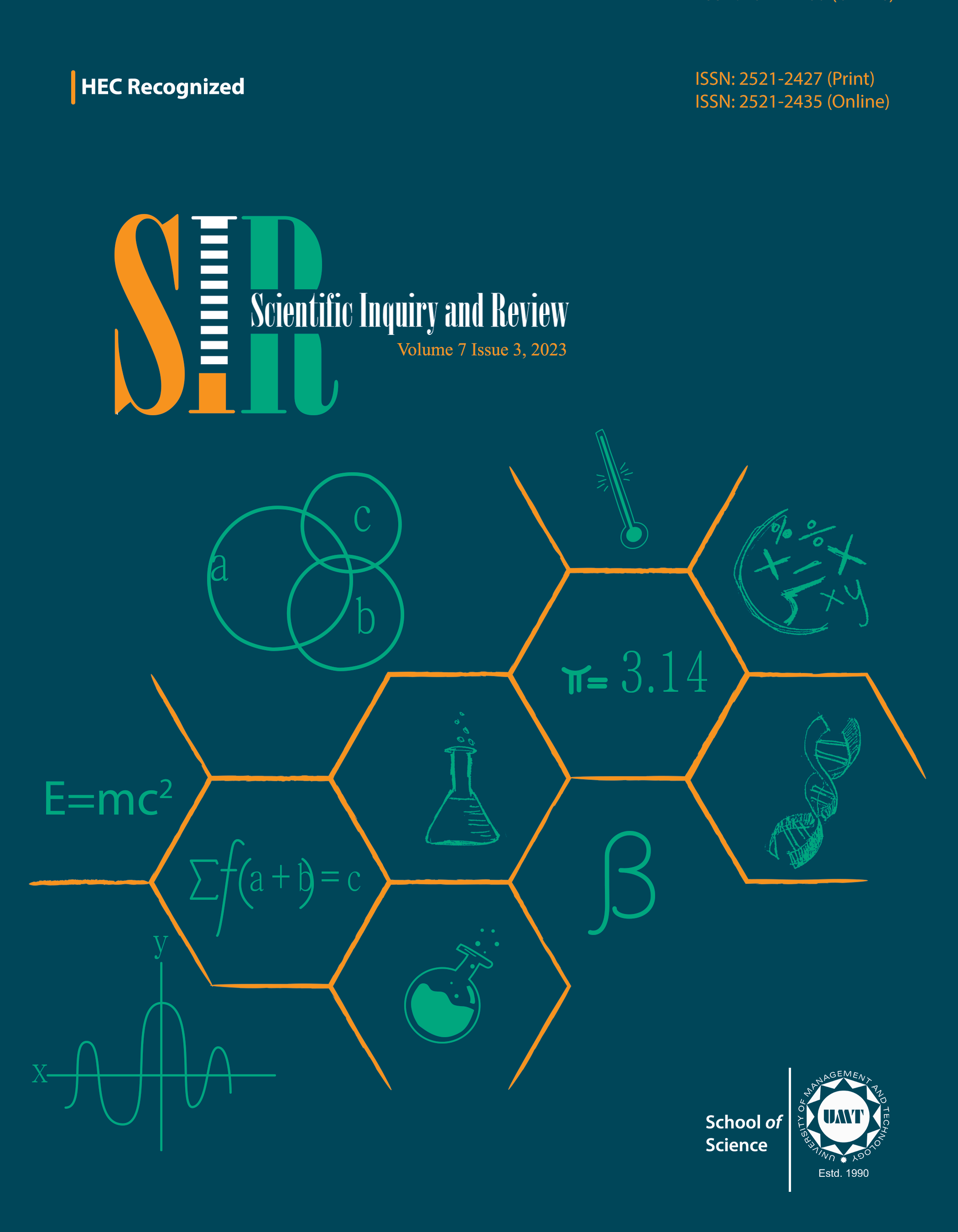Exploring Breast Cancer Texture Analysis through Multilayer Neural Networks
Abstract
 Abstract Views: 0
Abstract Views: 0
Breast cancer is a significant health problem for women globally; however, timely detection can reduce female morbidity and mortality. Early breast screening has become imperative for all women, though, adequate screening facilities are necessarily required in developing countries like Pakistan, where breast cancer is a leading cause of death. To encounter this chronic disease, various image processing techniques have been introduced to automatically diagnose breast cancer from digital mammograms. The current study deployed data from a population of 35 participants. The mammograms used for screening were 5 normal, 15 benign, and 15 malignant patients. The breast images were marked by the radiologist and the system was trained with normal, benign, and malignant classes. Moreover, Multilayer Neural Networks (MNN) based texture analysis methodology was adopted to distinguish normal, benign, and malignant breast images. Reportedly, an automated approach was used to detect breast conditions after conducting the analysis of digital mammograms. Statistical parameters, namely sum, mean, variance, standard deviation, kurtosis, skewness, energy, and entropy were calculated, analyzed, and compared for the normal, malignant, and benign breast images. The results indicated a 100% accuracy after the analysis. The results of the extracted statistical parameters were promising and reliable in distinguishing between normal, malignant, and benign breast mammograms, again indicating the need for early detection of the disease to minimize the risk of breast cancer among women.
Downloads
References
Li H, Zhuang S, Li D, Zhao J, Ma Y. Benign and malignant classification of mammogram images based on deep learning. Biomed Signal Proc Control. 2019;51:347–354. https://doi.org/10.1016/j.bspc.2019.02.017
Morman NA, Byrne L, Collins C, Reynolds K, Bell JG. Breast cancer risk assessment at the time of screening mammography: Perceptions and clinical management outcomes for women at high risk. J Gen Counsel. 2017;26(4):776–784. https://doi.org/10.1007/s10897-016-0050-y
Puliti D, Bucchi L, Mancini S, et al. Advanced breast cancer rates in the epoch of service screening: The 400,000 women cohort study from Italy. Eur J Cancer. 2017;75:109–116. https://doi.org/10.1016/j.ejca.2016.12.030
Khan NH, Duan SF, Wu DD, Ji XY. Better reporting and awareness campaigns needed for breast cancer in Pakistani women. Cancer Manag Res. 2021;13:212–2129. https://doi.org/10.2147/cmar.s270671
Menhas R, Umer S. Breast cancer among Pakistani women. Iran J Public Health. 2015;44(4):586–587.
Pisano ED, Gatsonis C, Hendrick E, et al. Diagnostic performance of digital versus film mammography for breast-cancer screening. New Eng J Med. 2005;353(17):1773–1783. https://doi.org/10.1056/nejmoa052911
Sung H, Ferlay J, Siegel RL, et al. Global cancer statistics 2020: GLOBOCAN estimates of incidence and mortality worldwide for 36 cancers in 185 countries. Cancer J Clinic. 2021;71(3):209–249.
Zahoor S, Lali IU, Khan MA, Javed K, Mehmood W. Breast cancer detection and classification using traditional computer vision techniques: A comprehensive review. Curr Med Imag Form Curr Med Imag Rev. 2021;16(10):1187–1200. https://doi.org/10.2174/1573405616666200406110547
Elizalde A, Pina L, Etxano J, Slon P, Zalazar R, Caballeros M. Additional US or DBT after digital mammography: Which one is the best combination? Acta Radiol. 2016;57(1):13–18.
Selove R, Kilbourne B, Fadden MK, et al. Time from screening mammography to biopsy and from biopsy to breast cancer treatment among Black and White, non-HMO Medicare women beneficiaries not participating in a health maintenance organization. Women Health Issue. 2016;26(6):642–647. https://doi.org/10.1016/j.whi.2016.09.003
Galván-Tejada C, Zanella-Calzada L, Galván-Tejada J, et al. Multivariate feature selection of image descriptors data for breast cancer with computer-assisted diagnosis. Diagnostics. 2017;7(1):e9. https://doi.org/10.3390/diagnostics7010009
Jiang J, Trundle P, Ren J. Medical image analysis with artificial neural networks. Comput Med Imag Graph. 2010;34(8):617–631. https://doi.org/10.1016/j.compmedimag.2010.07.003
Fujita H. AI-based computer-aided diagnosis (AI-CAD): The latest review to read first. Radiol Phy Technol. 2020;13(1):6–19. https://doi.org/10.1007/s12194-019-00552-4
Michell MJ, Iqbal A, Wasan RK, et al. A comparison of the accuracy of film-screen mammography, full-field digital mammography, and digital breast tomosynthesis. Clin Radiol. 2012;67(10):976–981. https://doi.org/10.1016/j.crad.2012.03.009
Dhahbi S, Barhoumi W, Zagrouba E. Breast cancer diagnosis in digitized mammograms using curvelet moments. Compute Biol Med. 2015;64:79–90. https://doi.org/10.1016/j.compbiomed.2015.06.012
Kamra A, Jain V, Singh S, Mittal S. Characterization of architectural distortion in mammograms based on texture analysis using support vector machine classifier with clinical evaluation. J Digit Imaging. 2016;29(1):104–114. https://doi.org/10.1007/s10278-015-9807-3
Kulkarni DA, Bhagyashree. SM, Udupi GR. Texture analysis of mammographic images. Int J Comput Appl. 2010;5(6):12–17. https://doi.org/10.5120/919-1297
Zhang C, Shao H, Li Y. Particle swarm optimisation for evolving artificial neural network. Paper presented at: SMC 2000 conference proceedings. 2000 IEEE International Conference on Systems, man and Cybernetics; October 8–11, 2000; Nashville, TN, USA. https://doi.org/10.1109/ICSMC.2000.884366
Sathya DJ, Geetha K. Mass classification in breast DCE-MR images using an artificial neural network trained via a bee colony optimization algorithm. ScienceAsia. 2013;39(3):294–305. https://doi.org/10.2306/scienceasia1513-1874.2013.39.294
Dheeba J, Singh NA, Selvi ST. Computer-aided detection of breast cancer on mammograms: A swarm intelligence optimized wavelet neural network approach. J Biomed Info. 2014;49:45–52. https://doi.org/10.1016/j.jbi.2014.01.010
Sharma M, Dubey RB, Gupta S. Feature extraction of mammograms. Int J Adv Comput Res. 2012;2(3):201–209.
Ranjbarzadeh R, Sarshar NT, Ghoushchi SJ, et al. MRFE-CNN: Multi-route feature extraction model for breast tumor segmentation in Mammograms using a convolutional neural network. Ann Oper Res. https://doi.org/10.1007/s10479-022-04755-8
Kayode AA, Afolabi BS, Ibitoye BO. Preparing mammograms for classification task: Processing and analysis of mammograms. Int J Info Eng Elect Bus. 2016;8(3):57–66. https://doi.org/10.5815/ijieeb.2016.03.07
Chan HP, Sahiner B, Petrick N, et al. Computerized classification of malignant and benign microcalcifications on mammograms: Texture analysis using an artificial neural network. Phy Med Biol. 1997;42(3):549–567. https://doi.org/10.1088/0031-9155/42/3/008
Copyright (c) 2023 Aalia Nazir

This work is licensed under a Creative Commons Attribution 4.0 International License.






